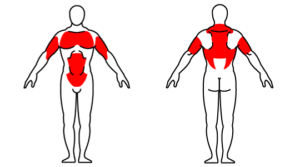Welcome to part two of our 20 part series of kettlebell workout routines. Today we are introducing the kettlebell renegade row excercise. Be warned, this is a tough kettlebell excercise but the results to the upper body are amazing.
Kettlebell Renegade Row
Contents
The renegade row was developed by John Davies and is based on the traditional push-up. The difference is that you push up with alternate arms. The kettlebell renegade row is an advanced kettlebell workout that requires patience, attention and focus. The routine requires constant use of two (identical) kettlebells. Balance is key, so kettlebells with rounded bottoms make this routine even tougher. You can also complete this routine with dumbbells. A great choice is an adjustable kettlebell or an adjustable dumbbell such as the Bowflex Selecttech 552. This will allow you to steadily add or remove weight as you progress.
If you have never attempted this routine, we recommend trying without any kettlebells. Instead, replace the kettlebell with the palm of your hand. This will enable you to get into the flow. Mastered it? Before jumping ahead with two kettlebells, attempt the routine with one.
Renegade Row Muscles worked
The renegade row will intensely work the following muscles:
- Abs
- Biceps
- Triceps
- Chest
- Lats
- Back

This routine will also work your core and improve your focus.
Renegade Row Benefits
The main benefit of the renegade row is the number of upper body muscles worked. You can use this routine to effectively replace working on your pecks and abs in isolation. Completing this routine regularly will develop your pecks and abs, improve core body strength and tone biceps, triceps and your back muscles.
Renegade Row Difficulty
The renegade row is considered an advanced kettlebell excercise. In order to complete this routine you need to be able to support yourself whilst on one arm. As well as requiring good upper body strength, you need to remain focused throughout.
Starting position
Start of by placing the kettlebells on the floor, parallel to one another and shoulder width apart. Facing the kettlebells, get down onto your knees so they are supporting all of your weight. Learn forward and wrap your hands around the kettlebell handles. As you do this, ensure your knuckles are facing outwards. This grip will ensure your wrists remain straight throughout. Finally push your self upwards with your arms, assuming a standing plank position. Ensure your back, arms, next and legs are all nice and straight. Your feet should be shoulder width apart with your toes acting as support.
Renegade Row Technique
Step 1 – Lifting the kettlebell. Keeping your shoulders over the kettlebells, shift your weight onto your right or left hand side. Doing this will create weightlessness on one side, allowing up to lift up the kettlebell. In one motion, bring the kettlebell all the way up to your chest.
You’ll want to avoid moving your hip upwards and any twisting of the torso.
Step 2 – Returning the kettlebell. Slowly and calmly lower the kettlebell back to the floor. Now that you are back in your starting position, shift your weight onto the other side and repeat. Before lifting the kettlebell, lock out everything. This improve your stability as you lift.
Tips
- If you find it siddifult to stop your hips moving backwards, try increasing the space between your legs. This will also be effective if you find your torso twisting.
Modified Renegade Row
For a really intense workout try:
- Increasing the weight of the kettlebell/dumbbell.
- Resting your feet on top of an excercise ball. This will reduce the amount of body weight supported by your feet, making it harder to push up.
- Combine the renegade row with a pushup renegade row. This involves introducing a push-up before steps 1 and 2.
For a less intense workout try:
- Using lighter kettlebells or try without.
- Using your knees for support instead of your feet. Checkout these plank variations.
Renegade Row Video
Lookout for part three of our kettlebell workout guide where I will be introducing the kettlebell windmill routine.
Missed part one? Click to find out how you can master the kettlebell sumo deadlift.
